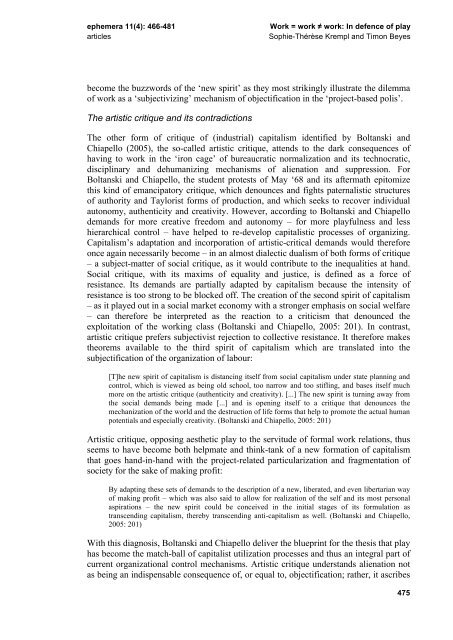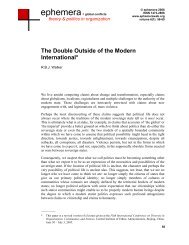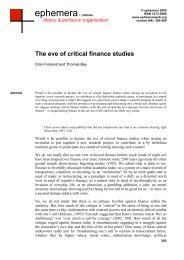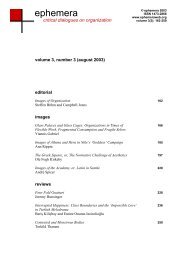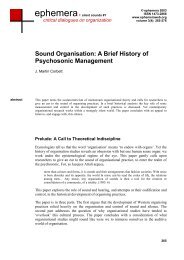Work, play and boredom - Ephemera
Work, play and boredom - Ephemera
Work, play and boredom - Ephemera
You also want an ePaper? Increase the reach of your titles
YUMPU automatically turns print PDFs into web optimized ePapers that Google loves.
ephemera 11(4): 466-481 <strong>Work</strong> = work " work: In defence of <strong>play</strong><br />
articles Sophie-Thérèse Krempl <strong>and</strong> Timon Beyes<br />
become the buzzwords of the ‘new spirit’ as they most strikingly illustrate the dilemma<br />
of work as a ‘subjectivizing’ mechanism of objectification in the ‘project-based polis’.<br />
The artistic critique <strong>and</strong> its contradictions<br />
The other form of critique of (industrial) capitalism identified by Boltanski <strong>and</strong><br />
Chiapello (2005), the so-called artistic critique, attends to the dark consequences of<br />
having to work in the ‘iron cage’ of bureaucratic normalization <strong>and</strong> its technocratic,<br />
disciplinary <strong>and</strong> dehumanizing mechanisms of alienation <strong>and</strong> suppression. For<br />
Boltanski <strong>and</strong> Chiapello, the student protests of May ‘68 <strong>and</strong> its aftermath epitomize<br />
this kind of emancipatory critique, which denounces <strong>and</strong> fights paternalistic structures<br />
of authority <strong>and</strong> Taylorist forms of production, <strong>and</strong> which seeks to recover individual<br />
autonomy, authenticity <strong>and</strong> creativity. However, according to Boltanski <strong>and</strong> Chiapello<br />
dem<strong>and</strong>s for more creative freedom <strong>and</strong> autonomy – for more <strong>play</strong>fulness <strong>and</strong> less<br />
hierarchical control – have helped to re-develop capitalistic processes of organizing.<br />
Capitalism’s adaptation <strong>and</strong> incorporation of artistic-critical dem<strong>and</strong>s would therefore<br />
once again necessarily become – in an almost dialectic dualism of both forms of critique<br />
– a subject-matter of social critique, as it would contribute to the inequalities at h<strong>and</strong>.<br />
Social critique, with its maxims of equality <strong>and</strong> justice, is defined as a force of<br />
resistance. Its dem<strong>and</strong>s are partially adapted by capitalism because the intensity of<br />
resistance is too strong to be blocked off. The creation of the second spirit of capitalism<br />
– as it <strong>play</strong>ed out in a social market economy with a stronger emphasis on social welfare<br />
– can therefore be interpreted as the reaction to a criticism that denounced the<br />
exploitation of the working class (Boltanski <strong>and</strong> Chiapello, 2005: 201). In contrast,<br />
artistic critique prefers subjectivist rejection to collective resistance. It therefore makes<br />
theorems available to the third spirit of capitalism which are translated into the<br />
subjectification of the organization of labour:<br />
[T]he new spirit of capitalism is distancing itself from social capitalism under state planning <strong>and</strong><br />
control, which is viewed as being old school, too narrow <strong>and</strong> too stifling, <strong>and</strong> bases itself much<br />
more on the artistic critique (authenticity <strong>and</strong> creativity). [...] The new spirit is turning away from<br />
the social dem<strong>and</strong>s being made [...] <strong>and</strong> is opening itself to a critique that denounces the<br />
mechanization of the world <strong>and</strong> the destruction of life forms that help to promote the actual human<br />
potentials <strong>and</strong> especially creativity. (Boltanski <strong>and</strong> Chiapello, 2005: 201)<br />
Artistic critique, opposing aesthetic <strong>play</strong> to the servitude of formal work relations, thus<br />
seems to have become both helpmate <strong>and</strong> think-tank of a new formation of capitalism<br />
that goes h<strong>and</strong>-in-h<strong>and</strong> with the project-related particularization <strong>and</strong> fragmentation of<br />
society for the sake of making profit:<br />
By adapting these sets of dem<strong>and</strong>s to the description of a new, liberated, <strong>and</strong> even libertarian way<br />
of making profit – which was also said to allow for realization of the self <strong>and</strong> its most personal<br />
aspirations – the new spirit could be conceived in the initial stages of its formulation as<br />
transcending capitalism, thereby transcending anti-capitalism as well. (Boltanski <strong>and</strong> Chiapello,<br />
2005: 201)<br />
With this diagnosis, Boltanski <strong>and</strong> Chiapello deliver the blueprint for the thesis that <strong>play</strong><br />
has become the match-ball of capitalist utilization processes <strong>and</strong> thus an integral part of<br />
current organizational control mechanisms. Artistic critique underst<strong>and</strong>s alienation not<br />
as being an indispensable consequence of, or equal to, objectification; rather, it ascribes<br />
475


